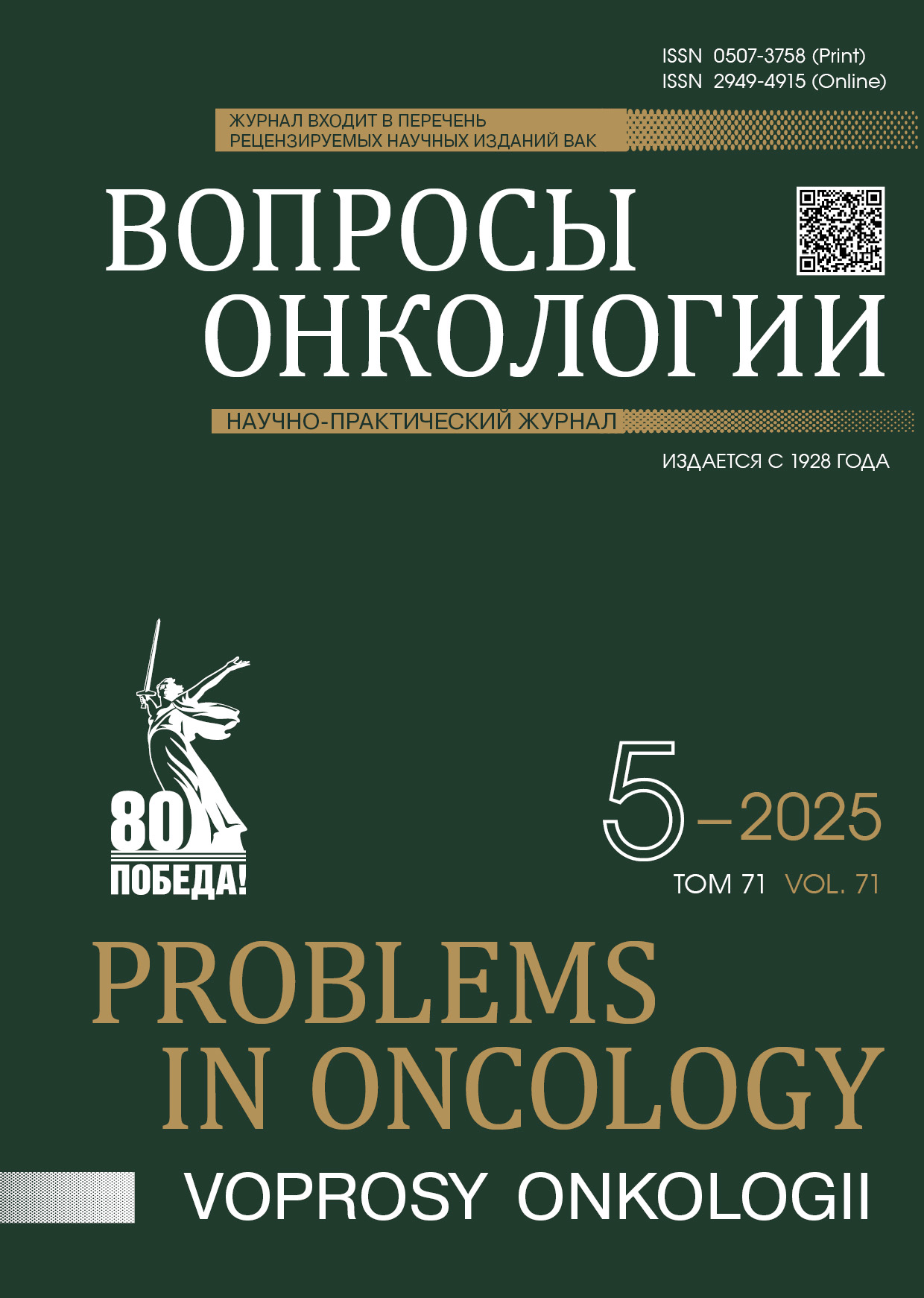Abstract
Aim. To evaluate the extent of resection and its impact on prognosis in patients with IDH wild-type glioblastoma.
Materials and methods. The treatment outcomes of 63 patients with IDH-wildtype grade 4 glioblastoma were analyzed. Radicality of resection was staged according to the Response Assessment in Neuro-oncology (RANO) criteria for assessing the extent of resection in glioblastoma (2023). Pre- and post-operative tumor volumes were measured by semi-automated or manual segmentation. Statistical analysis was performed using StatTech v. 4.7.0 (developer - Stattech LLC, Russia).
Results. When Cox regression was used to assess the relationship between overall survival and the pre- and post-operative volumes of the contrast-enhancing part of the glioblastoma and the FLAIR zone, the only predictor affecting survival was the post-operative volume of the contrast-enhancing part - for every 1 cm3 increase in the remaining volume of the contrast-enhancing part, the risk of death increased by 1.046 times (p = 0.018). When evaluating the relationship between overall survival and resection class according to the RANO criteria (2023), the differences in overall survival were statistically significant using the likelihood ratio test (p = 0.012). The risk of death increased 3.356-fold with resection class 3B.
Conclusion. Complete removal of the contrast-enhancing part of the glioblastoma is an important goal of surgical treatment, but the same cannot be said for the usefulness of FLAIR zone resection. The RANO criteria clearly demonstrate their value in assessing the extent of resection in patients with IDH wild-type glioblastoma.
References
Nelson T.A., Dietrich J. Investigational treatment strategies in glioblastoma: progress made and barriers to success. Expert Opin Investig Drugs. 2023; 32(10): 921-930.-DOI: 10.1080/13543784.2023.2267982.
Ali M.Y., Oliva C.R., Noman A.S.M., et al. Radioresistance in glioblastoma and the development of radiosensitizers. Cancers (Basel). 2020; 12(9): 2511.-DOI: 10.3390/cancers12092511.
Hassn Mesrati M., Behrooz A.B., Y. Abuhamad A., et al. Understanding Glioblastoma Biomarkers: Knocking a Mountain with a Hammer. Cells. 2020; 9(5): 1236.-DOI: 10.3390/cells9051236.
Schonberg D.L., Lubelski D., Miller T.E., et al. Brain tumor stem cells: Molecular characteristics and their impact on therapy. Mol Aspects Med. 2014; 39: 82-101.-DOI: 10.1016/j.mam.2013.06.004.
Чернов А., Балдуева И., Нехаева Т., et al. Молекулярные механизмы множественной лекарственной устойчивости глиобластом человека. Вопросы онкологии. 2022; 67(1), 20-28.-DOI: 10.37469/0507-3758-2021-67-1-20-28.
[Chernov A., Baldueva I., Nekhaeva T., et al. The molecular mechanisms of multidrug resistance of human glioblastomas. Voprosy Onkologii = Problems in Oncology. 2022; 67(1): 20-28.-DOI: 10.37469/0507-3758-2021-67-1-20-28 (In Rus)].
Brown T.J., Brennan M.C., Li M., et al. Association of the extent of resection with survival in glioblastoma: A systematic review and meta-analysis. JAMA Oncol. 2016; 2(11): 1460-1469.-DOI: 10.1001/jamaoncol.2016.1373.
Nabors L.B., Portnow J., Ahluwalia M., et al. Central nervous system cancers, version 3.2020, NCCN clinical practice guidelines in oncology. J Natl Compr Canc Netw. 2020; 18(11): 1537-1570.-DOI: 10.6004/jnccn.2020.0052.
Li Y.M., Suki D., Hess K., et al. The influence of maximum safe resection of glioblastoma on survival in 1229 patients: Can we do better than gross-total resection? J Neurosurg. 2016; 124(4): 977-988.-DOI: 10.3171/2015.5.JNS142087
Dimou J., Beland B., Kelly J. Supramaximal resection: A systematic review of its safety, efficacy and feasibility in glioblastoma. J Clin Neurosci. 2020; 72: 328-334.-DOI: 10.1016/j.jocn.2019.12.021.
Лахина Ю.С., Гуляев Д.А., Красношлык П.В., et al. Тактика хирургического лечения глиобластом с различными МР-характеристиками. Саратовский научно-медицинский журнал. 2020; 16(4): 912-916.
[Lakhina Yu.S., Gulyaev D.A., Krasnoshlyk P.V., et al. Surgical treatment of glioblastomas with various MR characteristics. Saratov Journal of Medical Scientific Research. 2020; 16(3): 912-916 (in Rus)].
Karschnia P., Young J.S., Dono A., et al. Prognostic validation of a new classification system for extent of resection in glioblastoma: A report of the RANO resect group. Neuro Oncol. 2023; 25(5): 940-954.-DOI: 10.1093/neuonc/noac193.
Wykes V., Zisakis A., Irimia M., et al. Importance and evidence of extent of resection in glioblastoma. J Neurol Surg Part A Cent Eur Neurosurg. 2021; 82: 075-086.-DOI: 10.1055/s-0040-1701635.
Revilla-Pacheco F., Rodríguez-Salgado P., Barrera-Ramírez M., et al. Extent of resection and survival in patients with glioblastoma multiforme: Systematic review and meta-analysis. Medicine. 2021; 100: e26432.-DOI: 10.1097/MD.0000000000026432.
Lacroix M., Abi-Said D., Fourney D.R., et al. A multivariate analysis of 416 patients with glioblastoma multiforme: prognosis, extent of resection, and survival. Journal of Neurosurgery. 2001; 95(2): 190-198.-DOI: 10.3171/jns.2001.95.2.0190.
Kuhnt D., Becker A., Ganslandt O., et al. Correlation of the extent of tumor volume resection and patient survival in surgery of glioblastoma multiforme with high-field intraoperative MRI guidance. Neuro-oncology. 2011; 13(12): 1339-1348.-DOI: 10.1093/neuonc/nor133.
Orringer D., Lau D., Khatri S., et al. Extent of resection in patients with glioblastoma: limiting factors, perception of resectability, and effect on survival. Journal of neurosurgery. 2012; 117(5): 851-859.-DOI: 10.3171/2012.8.JNS12234.
Grabowski M.M., Recinos P.F., Nowacki A.S., et al. Residual tumor volume versus extent of resection: predictors of survival after surgery for glioblastoma. Journal of neurosurgery. 2014; 121(5): 1115-1123.-DOI: 10.3171/2014.7.JNS132449
Gerritsen J.K.W., Zwarthoed R.H., Kilgallon J.L., et al. Impact of maximal extent of resection on postoperative deficits, patient functioning, and survival within clinically important glioblastoma subgroups. Neuro-oncology. 2023; 25(5): 958-972.-DOI: 10.1093/neuonc/noac255.
Karschnia P., Vogelbaum M.A., van den Bent M., et al. Evidence-based recommendations on categories for extent of resection in diffuse glioma. European journal of cancer. 2021; 149: 23-33.-DOI: 10.1016/j.ejca.2021.03.002.
Bjorland L.S., Mahesparan R., Fluge Ø., et al. Impact of extent of resection on outcome from glioblastoma using the RANO resect group classification system: a retrospective, population-based cohort study. Neuro-oncology advances. 2023; 5(1): vdad126.-DOI: 10.1093/noajnl/vdad126.
Guerrini F., Roca E., Spena G. Supramarginal resection for glioblastoma: it is time to set boundaries! A critical review on a hot topic. Brain Sci. 2022; 12(5): 652.-DOI: 10.3390/brainsci12050652.
Karschnia P., Gerritsen J.K.W., Teske N., et al. The oncological role of resection in newly diagnosed diffuse adult-type glioma defined by the WHO 2021 classification: a Review by the RANO resect group. The Lancet. Oncology. 2024; 25(9): e404-e419.-DOI: 10.1016/S1470-2045(24)00130-X.

This work is licensed under a Creative Commons Attribution-NonCommercial-NoDerivatives 4.0 International License.
© АННМО «Вопросы онкологии», Copyright (c) 2025

